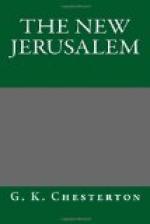of those houses of gold full of hard highly coloured
pictures, I fancied it came to me. It was the
Empire. And certainly not the raid of Asiatic
bandits we call the Turkish Empire. The thing
which had caught my eye in that coloured interior
was the carving of a two-headed eagle in such a position
as to make it almost as symbolic as a cross.
Every one has heard, of course, of the situation which
this might well suggest, the suggestion that the Russian
Church was far too much of an Established Church and
the White Czar encroached upon the White Christ.
But as a fact the eagle I saw was not borrowed from
the Russian Empire; it would be truer to say that
the Empire was borrowed from the eagle. The double
eagle is the ancient emblem of the double empire of
Rome and of Byzantium; the one head looking to the
west and the other to the east, as if it spread its
wings from the sunrise to the sunset. Unless
I am mistaken, it was only associated with Russia as
late as Peter the Great, though it had been the badge
of Austria as the representative of the Holy Roman
Empire. And what I felt brooding over that shrine
and that landscape was something older not only than
Turkey or Russia but than Austria itself. I began
to understand a sort of evening light that lies over
Palestine and Syria; a sense of smooth ruts of custom
such as are said to give a dignity to the civilisation
of China. I even understood a sort of sleepiness
about the splendid and handsome Orthodox priests moving
fully robed about the streets. They were not
aristocrats but officials; still moving with the mighty
routine of some far-off official system. In so
far as the eagle was an emblem not of such imperial
peace but of distant imperial wars, it was of wars
that we in the West have hardly heard of; it was the
emblem of official ovations.
When Heracleius rode homewards from the rout of Ispahan
With the captives dragged behind him and the eagles
in the van.
That is the rigid reality that still underlay the
light mastery of the Arab rider; that is what a man
sees, in the patchwork pavilion, when he grows used
to the coloured canvas and looks at the walls of stone.
This also was far too great a thing for facile praise
or blame, a vast bureaucracy busy and yet intensely
dignified, the most civilised thing ruling many other
civilisations. It was an endless end of the world;
for ever repeating its rich finality. And I myself
was still walking in that long evening of the earth;
and Caesar my lord was at Byzantium.
But it is necessary to remember next that this empire
was not always at its evening. Byzantium was
not always Byzantine. Nor was the seat of that
power always in the city of Constantine, which was
primarily a mere outpost of the city of Caesar.
We must remember Rome as well as Byzantium; as indeed
nobody would remember Byzantium if it were not for
Rome. The more I saw of a hundred little things
the more my mind revolved round that original idea
which may be called the Mediterranean; and the fact
that it became two empires, but remained one civilisation,
just as it has become two churches, but remained one
religion.




